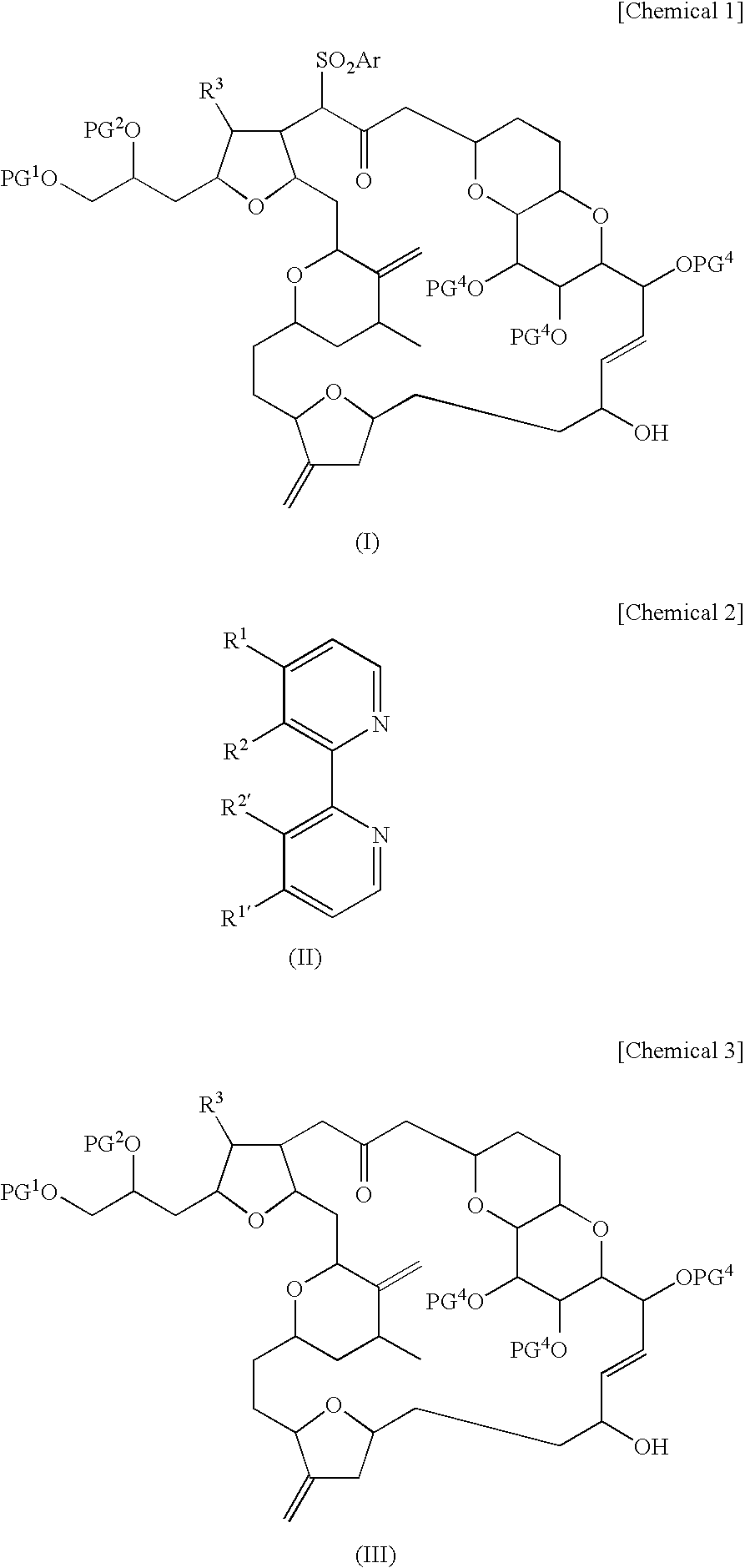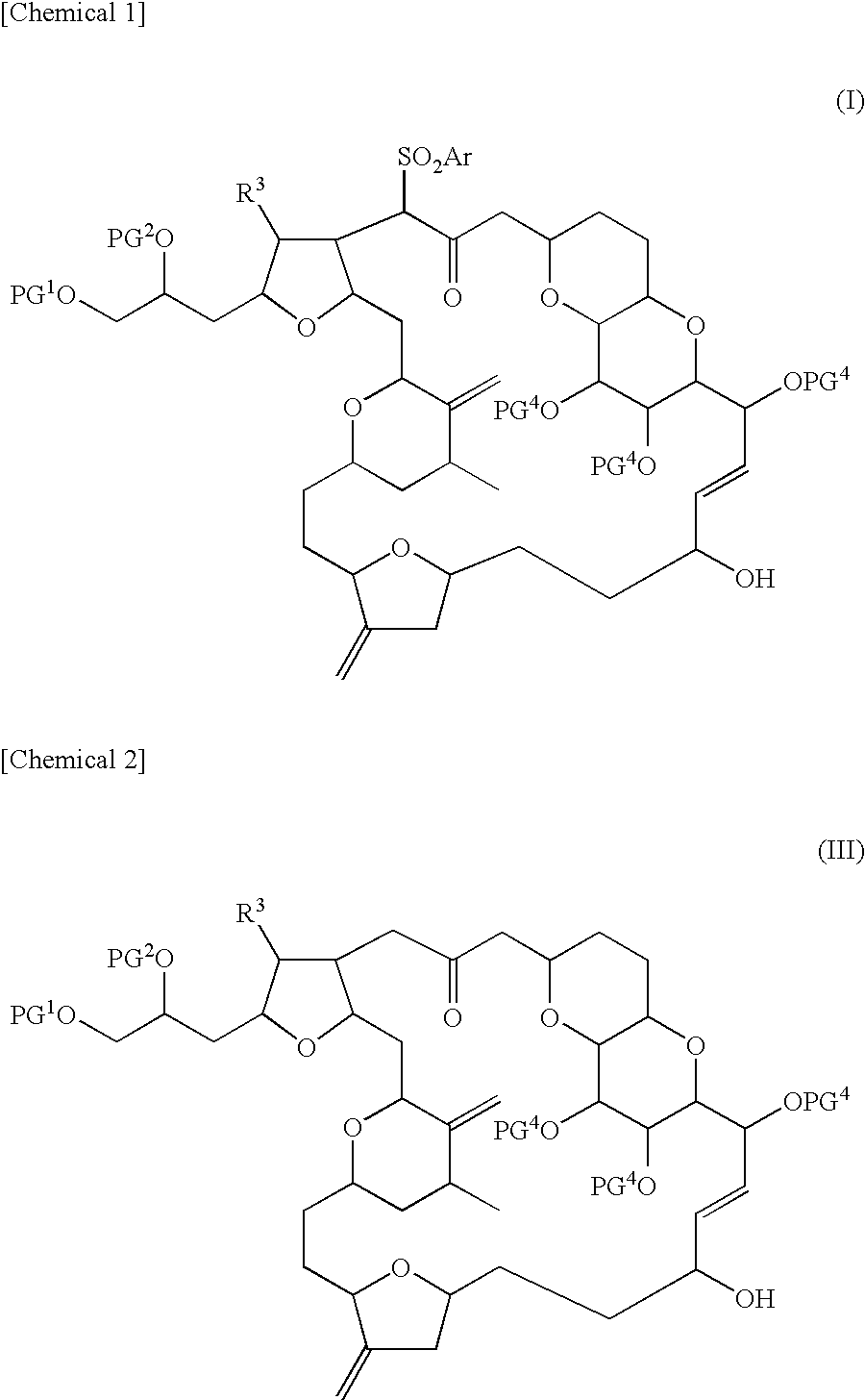Novel intermediate for halichondrin b analog synthesis and novel desulfonylation reaction used for the intermediate
a desulfonylation reaction and intermediate technology, applied in the field of new compounds, can solve the problems of high price of smisub>2 /sub>, not easy to handle smisub>2 /sub>, desulfonylation reaction, etc., and achieve the effect of convenient use, good yield and easy handling
- Summary
- Abstract
- Description
- Claims
- Application Information
AI Technical Summary
Benefits of technology
Problems solved by technology
Method used
Image
Examples
example 1
Production Example 1 of ER-413207
[0056]
[0057]4,4′-di-t-butyl-bipyridyl (3.4 mg, 0.0126 mmol, 0.10 molar equivalents), CrCl3 (2.0 mg, 0.0126 mmol, 0.10 molar equivalents), a manganese powder (27.7 mg, 0.504 mmol, 4.0 molar equivalents) and bis(cyclopentadienyl)zirconium dichloride (55.2 mg, 0.189 mmol, 1.5 molar equivalents) were weighed and placed in a reaction vessel, and then the atmosphere in the reaction vessel was replaced by a nitrogen gas. In the reaction vessel, THF (2.0 ml, anhydrous, free from stabilizer) was added, followed by stirring at room temperature for 90 minutes. Under a nitrogen atmosphere, 2,9-dimethyl-1,10-phenanthroline (2.6 mg, 0.0126 mmol, 0.10 molar equivalents) and NiCl2-DME complex (2.8 mg, 0.0126 mmol, 0.10 molar equivalents) were added, followed by stirring at room temperature for 30 minutes. To the resultant reaction solution, a THF solution (10 ml) of ER-804030 (200 mg) was added, followed by stirring at room temperature for 2 hours. After confirming ...
example 2
Production Example 2 of ER-413207
[0060]
[0061]Under a nitrogen atmosphere, a CrCl3 / 4,4′-di-t-butyl-bipyridyl catalyst (5.4 mg, 0.0126 mmol, 0.10 molar equivalents), a NiCl2 / 2,9-dimethyl-1,10-phenanthroline catalyst (4.3 mg, 0.0126 mmol, 0.10 molar equivalents), a manganese powder (27.7 mg, 0.504 mmol, 4.0 molar equivalents) and bis(cyclopentadienyl)zirconium dichloride (55.2 mg, 0.189 mmol, 1.5 molar equivalents) were weighed and placed in a 50 ml recovery flask and anhydrous THF (8.0 ml, 40 μl / mg, free from stabilizer, dried over molecular sieves 4A) was added, and then the resultant reaction solution was stirred for 30 minutes. In the reaction solution, an anhydrous THF solution (4.0 ml) of ER-804030 (200 mg, 0.126 mmol) was added and the resultant mixture was stirred under a nitrogen atmosphere at room temperature (25° C.) for 6 hours. After confirming the completion of the reaction by HPLC, the reaction solution was diluted with ethyl acetate (100 ml) under air. The resultant sol...
example 3
Production Example 3 of ER-413207
[0062]
[0063]This Example was carried out with reference to an example (paragraph [00206]) described in the pamphlet of International Publication No. WO 2005 / 118565.
[0064]ER-807063 (1.9 g, 6.40 mmol) was weighed and placed in a reaction vessel, acetonitrile (27 ml) was added and dissolved. In the resultant reaction solution, CrCl2 (800 mg, 6.51 mmol) and triethylamine (0.8 ml, 6.00 mmol) were added, followed by stirring at about 30° C. for 3 hours. The reaction vessel was cooled to 15° C. and NiCl2 (100 mg, 0.771 mmol) was introduced, and then a preliminarily prepared THF-ACN mixed solution (THF / ACN=84 / 16, 31 mL) of ER-804030 was added dropwise to the reaction solution over 30 minutes. After the completion of the addition of the ER-804030 solution, the reaction mixture was stirred at a temperature within a range from 15 to 21° C. for 3 hours while gradually heating and heptane (25 ml) was introduced into the reaction mixture. The reaction mixture was ...
PUM
| Property | Measurement | Unit |
|---|---|---|
| temperature | aaaaa | aaaaa |
| temperature | aaaaa | aaaaa |
| temperature | aaaaa | aaaaa |
Abstract
Description
Claims
Application Information
 Login to View More
Login to View More - R&D
- Intellectual Property
- Life Sciences
- Materials
- Tech Scout
- Unparalleled Data Quality
- Higher Quality Content
- 60% Fewer Hallucinations
Browse by: Latest US Patents, China's latest patents, Technical Efficacy Thesaurus, Application Domain, Technology Topic, Popular Technical Reports.
© 2025 PatSnap. All rights reserved.Legal|Privacy policy|Modern Slavery Act Transparency Statement|Sitemap|About US| Contact US: help@patsnap.com



